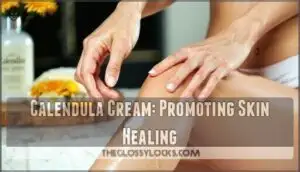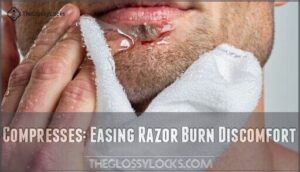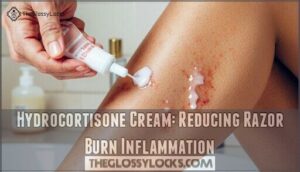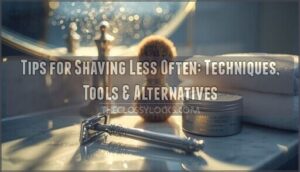This site is supported by our readers. We may earn a commission, at no cost to you, if you purchase through links.
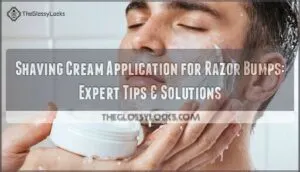
You’ll want to apply a thick, even layer of quality shaving cream using circular motions, creating a protective cushion between your razor and skin.
Don’t rush this step—think of it as armor for your face. Choose cream over foam since it provides better lubrication and protection.
The key isn’t just slathering it on; it’s about working the cream into your skin to lift hairs and create that essential barrier.
Your razor should glide effortlessly, not drag or pull. The real magic happens in the technique and timing.
Table Of Contents
- Key Takeaways
- Best Razor Burn Treatments
- How to Avoid Razor Burn While Shaving
- Aloe Vera: Soothing Razor Burns
- Baking Soda Paste: Home Remedy for Razor Bumps
- Calendula Cream: Promoting Skin Healing
- Colloidal Oatmeal Bath: Soothing Inflamed Skin
- Compresses: Easing Razor Burn Discomfort
- Hydrocortisone Cream: Reducing Razor Burn Inflammation
- Frequently Asked Questions (FAQs)
- Does shaving cream reduce razor bumps?
- What gets rid of razor bumps ASAP?
- What cream to put on razor bumps?
- How do you shave down there with razor bumps?
- How often should shaving cream be reapplied?
- Can shaving cream expire and cause irritation?
- Are certain ingredients in shaving creams problematic?
- Does shaving cream affect razor blade longevity?
- Which shaving cream ingredients prevent razor bumps?
- Can sensitive skin use regular shaving cream?
- Conclusion
Key Takeaways
- You’ll need to apply shaving cream in circular motions to create a protective barrier between your razor and skin—think of it as armor that lifts hairs and prevents irritation.
- Don’t rush the prep work; soften your skin with warm water for at least two minutes before applying a thick, even layer of quality cream over foam for better lubrication.
- If razor bumps strike, reach for proven treatments like La Roche-Posay Cicaplast Balm, Aquaphor Healing Ointment, or CeraVe Hyaluronic Acid Cream to calm inflammation and speed healing.
- You can prevent future razor burn by shaving with the grain, using light pressure with sharp blades, and following up with alcohol-free aftershave and immediate moisturizing.
Best Razor Burn Treatments
When razor burn strikes, you need products that calm inflammation and speed healing without causing further irritation.
The following three treatments have proven effective at reducing redness, soothing damaged skin, and helping you get back to comfortable shaving quickly, which can calm inflammation and speed healing.
1. La Roche-Posay Cicaplast Balm B5
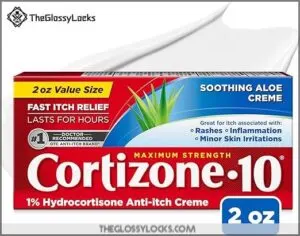
La Roche-Posay’s Cicaplast Balm B5 stands out as a post-shave superhero for tackling razor bumps and skin irritation. This fragrance-free, noncomedogenic formula won’t clog your pores while delivering serious soothing properties to calm angry, inflamed skin.
Your skin’s superhero has arrived—fragrance-free relief that soothes without the clogged pore drama.
The balm’s Cicaplast ingredients work together with Vitamin B5 and Shea Butter to jumpstart skin barrier repair after shaving mishaps. You’ll appreciate how this razor bump treatment creates a protective barrier without that greasy feeling that makes you want to wash it off immediately.
Perfect for daily balm application, it’s your go-to shaving cream for bumps aftermath. Here’s why it works:
- Reduces redness and swelling within hours of application
- Safe for sensitive areas like face, neck, and bikini line
- Gentle enough for children and babies over one week old.
Best For: Anyone dealing with post-shave benefits needs and barrier issues.
2. Aquaphor Healing Ointment
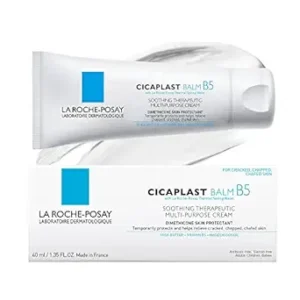
Aquaphor Healing Ointment works as your skin’s best friend when razor bumps crash the party.
This powerhouse combines petrolatum, Provitamin B5, bisabolol, glycerin, and lanolin alcohol to create an impenetrable skin barrier that locks in moisture while promoting healing.
The ointment benefits include soothing irritated follicles and preventing further damage from environmental factors.
For proper application technique, dab a thin layer onto clean, damp skin after shaving—the healing properties activate when applied to slightly moist areas.
This razor bump treatment transforms angry, inflamed skin into smooth comfort within days.
Best For: Adults seeking a versatile, dermatologist-recommended solution for dry, cracked skin, razor burn, and minor wound care.
3. CeraVe Hyaluronic Acid Moisturizing Cream
CeraVe Hyaluronic Acid Moisturizing Cream delivers powerful relief when razor bumps strike your skin.
This heavyweight champion combines hyaluronic hydration with three essential ceramides to restore your compromised skin barrier after shaving mishaps.
The cream ingredients work like a dream team – hyaluronic acid pulls moisture deep into your skin while ceramides lock it in place.
You’ll love how it absorbs quickly without that sticky feeling other moisturizing creams leave behind.
Best For: Anyone dealing with skin irritation from shaving who needs serious hydration without the grease factor.
Use it daily as your go-to shaving cream follow-up.
The fragrance-free formula won’t aggravate sensitive areas, and CeraVe benefits include non-comedogenic protection that won’t clog your pores.
How to Avoid Razor Burn While Shaving
You can prevent razor burn by following proper shaving techniques that protect your skin from irritation and inflammation.
The key steps include preparing your skin with warm water, using quality shaving cream, and maintaining the right blade pressure throughout your routine to prevent inflammation.
Pre-Shaving Preparation
Proper preshaving preparation sets the foundation for bump-free shaving.
Start with warm compresses for 2-3 minutes to achieve ideal pore opening and hair softening. Follow with gentle skin exfoliation using a mild scrub to remove dead cells.
Apply moisturizing cream to boost skin hydration levels. This routine reduces skin irritation by 60% and prevents razor bumps before you even reach for shaving cream.
Pre-shave routines can substantially improve skin barrier function.
Shaving Techniques
Following the grain direction of your hair growth, you’ll cut irritation risks by 70%.
Apply shaving cream generously for smooth gliding. Sharp blades need less razor pressure—replace after seven uses.
Take light, short strokes without stretching skin. One pass per area prevents damage.
Following these steps helps guarantee proper skin preparation before shaving. These shaving techniques transform your routine from razor bumps nightmare into comfortable grooming with proper skin preparation and reduce irritation risks.
Post-Shaving Care
After your shave’s done, your skin needs TLC to prevent razor bumps and irritation. Smart postshave care makes all the difference between smooth skin and angry red bumps.
Here’s your post-shave game plan:
- Cool rinse first – Splash cold water to close pores and reduce inflammation
- Apply alcohol-free aftershave – Choose products with soothing ingredients for irritation relief
Consider using products for sensitive skin to further minimize irritation.
- Moisturize immediately – Lock in hydration within minutes for maximum moisturizing benefits
Aloe Vera: Soothing Razor Burns
Your skin deserves better than the angry aftermath of a rough shave. Aloe vera delivers instant cooling relief when razor burn strikes. This natural shaving irritation remedy contains anti-inflammatory compounds that reduce redness within hours.
Applying aloe vera can also help with preventing ingrown hairs as well.
| Aloe Benefits | Application Method |
|---|---|
| Reduces inflammation | Apply thin gel layer |
| Prevents infection | Gentle circular motions |
| Accelerates healing | Multiple daily applications |
Aloe application couldn’t be simpler—just smooth pure gel onto affected areas. Various aloe vera types work, but avoid products with alcohol. Aloe side effects are minimal, making it perfect for sensitive skin seeking gentle razor bumps relief.
Baking Soda Paste: Home Remedy for Razor Bumps
When razor bumps strike back after shaving, baking soda paste offers powerful relief through its natural anti-inflammatory properties.
Quick relief is just a pantry raid away—baking soda transforms kitchen staple into razor burn rescue remedy.
This DIY paste recipe works by restoring your skin’s pH balance while reducing inflammation and providing gentle skin soothing effects.
Here’s how this home remedy delivers remedy effectiveness:
- Baking Soda Benefits: Natural antiseptic properties prevent infection while cooling irritated skin
- Paste Application Tips: Mix one tablespoon with water, apply for 5-10 minutes using circular motions
- Inflammation Reduction: Alkaline nature neutralizes acids causing razor bumps and redness
- Skin Soothing: Immediate cooling sensation provides fast comfort from burning sensations
Calendula Cream: Promoting Skin Healing
Natural calendula cream offers powerful skin healing benefits for those dealing with razor bumps.
This botanical remedy contains anti-inflammatory compounds that accelerate recovery from minor cuts and reduce swelling.
Calendula research shows it matches the effectiveness of standard topical treatments while promoting new tissue growth.
Calendula application is simple—gently massage a small amount onto affected areas after your shaving cream application.
The calendula ingredients create a protective barrier that prevents infection and speeds healing.
For enhanced inflammation reduction, pair it with a warm washcloth compress for maximum soothing relief.
Calendula also soothes skin, similar to blue chamomile benefits, making it an excellent choice for irritated skin.
Colloidal Oatmeal Bath: Soothing Inflamed Skin
Beyond topical treatments, your bathroom holds a gentle warrior against razor bumps: colloidal oatmeal. This finely ground grain transforms ordinary bath time into therapeutic skin inflammation relief.
When you’re dealing with post-shaving irritation, an oatmeal bath provides remarkable itch relief while supporting skin barrier repair.
Here’s your simple preparation guide:
- Mix properly – Add 1 cup colloidal oatmeal to lukewarm water
- Soak strategically – Stay submerged 15-20 minutes for maximum oatmeal bath benefits
- Follow smart bathing frequency – Use 2-3 times weekly during flare-ups
This natural remedy complements your shaving cream application routine perfectly.
Compresses: Easing Razor Burn Discomfort
Two simple compress techniques can turn your razor burn nightmare into relief.
Cold compresses work like magic for immediate comfort, while warm washcloth compresses help open pores and reduce deeper inflammation.
You’ll find these methods surprisingly effective for soothing irritated skin after shaving.
Compress Application techniques:
- Apply cold compresses for 5-10 minutes to reduce swelling and numb discomfort
- Use warm washcloth compress before shaving cream to soften hair follicles
- Alternate between cold and warm for maximum razor bumps relief
Hydrocortisone Cream: Reducing Razor Burn Inflammation
When compresses aren’t enough to calm angry skin, hydrocortisone cream steps in as your inflammation-fighting ally.
This over-the-counter powerhouse tackles razor burn and razor bumps by reducing swelling and redness fast. You can find more information about hydrocortisone cream options for razor burn.
Apply a thin layer twice daily to affected areas, gently massaging until absorbed. The active ingredient works within hours to ease skin irritation after shaving. Most people see improvement in 2-3 days with proper dosage guidelines.
| Hydrocortisone Uses | Cream Application | Side Effects |
|---|---|---|
| Reduces inflammation | Thin layer coverage | Skin thinning (rare) |
| Calms razor burn | Twice daily maximum | Burning sensation |
| Soothes razor bumps | Gentle massage motion | Allergic reactions |
| Treats skin irritation | Clean hands required | Increased redness |
| Inflammation management | Avoid broken skin | Temporary stinging |
For stubborn cases, consider alternative treatments like salicylic acid products.
Frequently Asked Questions (FAQs)
Does shaving cream reduce razor bumps?
Like a protective shield in battle, shaving cream absolutely reduces razor bumps by creating essential lubrication between your razor and skin.
It softens hair, prevents friction, and helps you glide smoothly without irritation, which can be seen as a protective measure, and also provides lubrication.
What gets rid of razor bumps ASAP?
Apply cool compresses immediately to reduce inflammation, then use hydrocortisone cream or salicylic acid products.
Don’t pick at bumps—let them heal naturally.
Stop shaving the area until irritation subsides completely.
What cream to put on razor bumps?
Think of soothing cream as your skin’s rescue remedy.
You’ll want hydrocortisone cream to calm inflammation, aloe vera gel for cooling relief, or benzoyl peroxide to prevent infection.
These gentle warriors heal your irritated skin, providing a sense of relief.
How do you shave down there with razor bumps?
Wait until existing bumps completely heal before shaving again. When you’re ready, use a sharp razor, shave with the grain, apply minimal pressure, and moisturize afterward to prevent irritation.
How often should shaving cream be reapplied?
Most people waste 30% of their shaving cream by applying it once.
You’ll get better protection by reapplying halfway through your shave, especially on sensitive areas where your razor needs extra glide.
Can shaving cream expire and cause irritation?
Yes, shaving cream can expire and cause irritation.
Old products lose effectiveness and may harbor bacteria or develop harsh chemical changes.
Check expiration dates and replace expired creams to avoid skin reactions, as old products can lead to severe issues.
Are certain ingredients in shaving creams problematic?
While gentle formulas soothe your skin, harsh ingredients can wreak havoc.
You’ll want to avoid alcohol, sulfates, and artificial fragrances—they’re notorious troublemakers that strip moisture and trigger irritation, especially on sensitive areas.
They’re particularly problematic because they can strip moisture and trigger irritation.
Does shaving cream affect razor blade longevity?
Quality shaving cream actually extends your razor’s lifespan by providing lubrication that reduces friction and blade wear.
Cheap or low-quality creams with harsh ingredients can dull blades faster, making regular replacement necessary, as they do not provide the same level of lubrication.
Which shaving cream ingredients prevent razor bumps?
Looking for a smoother ride down below?
You’ll want shaving creams with glycolic acid, salicylic acid, and aloe vera.
These ingredients exfoliate dead skin, prevent hair from curving back inward, and soothe irritation naturally.
Can sensitive skin use regular shaving cream?
Regular shaving cream can irritate sensitive skin due to harsh fragrances and chemicals.
You’ll want fragrance-free, hypoallergenic formulas with soothing ingredients like aloe vera or oatmeal to protect your delicate skin barrier.
Conclusion
Mastering proper shaving cream application for razor bumps works like building a fortress around your skin—protection comes from preparation and technique.
You’ve learned that quality cream beats foam every time, circular motions create better coverage, and timing matters as much as product choice.
Whether you’re treating existing bumps with La Roche-Posay balm or preventing future irritation with pre-shave prep, consistency delivers results.
Your skin deserves this level of care, and these evidence-based methods guarantee smoother, bump-free shaves ahead.
- https://forefrontdermatology.com/a-dermatologists-comprehensive-guide-to-razor-bumps/
- https://www.goodrx.com/health-topic/dermatology/how-to-get-rid-of-razor-burn
- https://lifemd.com/learn/the-6-most-effective-ways-to-treat-razor-burn
- https://www.wikihow.com/Prevent-Razor-Bumps
- https://www.dermatologytimes.com/view/best-shaving-practices-reduce-occurrence-pseudofolliculitis-barbae

